Introduction

To me the TTArtisan 90mm 1.25 was an unexpected lens, as Leica just recently put a 90mm 1.5 for 14 grand on the shelves, I did not expect anyone offering a faster 90mm M-mount lens. But here we are with a very chunky and massive 90mm 1.25 portrait lens. But is this the new M-mount bokeh king or is the design simply too ambitious? Let us find out in this review!
Lens is being tested on 42mp Sony A7rII and 24mp Leica M10
Sample Images





You can find most of the sample pictures from this review here on flickr in full resolution.
Contents
Specifications / Version History
The TTArtisan 90mm 1.25 is one of a kind as (at least to my knowledge) there has never been a 90mm lens with a maximum aperture of f/1.25 before. It has the following specifications:
-
- Diameter: 81 mm
- Field of view: 27° (diagonally)
- Length: 94 mm
- Weight: 1020g (without hood and caps)
- Filter Diameter: 77 mm
- Number of Aperture Blades: 10 (inwardly curved)
- Elements/Groups: 11/7
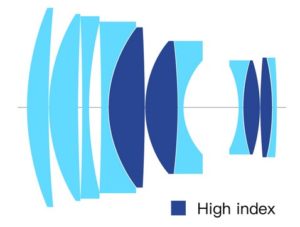
- Close Focusing Distance: 1.0 m
- Maximum Magnification: 1:9.7
- Mount: Leica-M
The TTArtisan 90mm 1.25 can be bought new for $769 at the manufacturer’s shop, amazon.com, ebay.com/ebay.de or B&H (affiliate links).
Handling / Build Quality

From the outer apperance this looks very much like a Leica M lens including the famous red dot. Markings are yellow/white (engraved and filled with paint), focus ring has a high albeit to me very nice resistance and turns about 160° from the minimum focus distance of 1.0 m to infinity.
The aperture ring has equidistant and rather soft half-stop click stops and feels very tightly assembled.
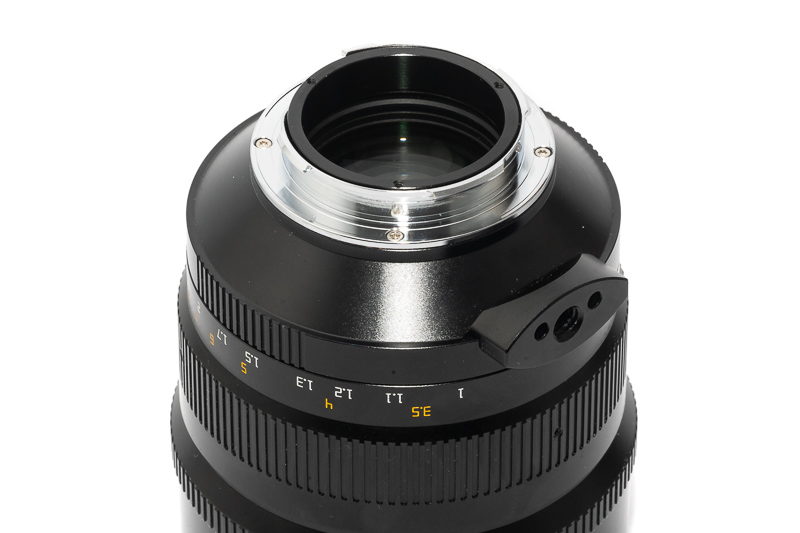
The lens features a rangefinder coupling which can be adjusted yourself using a small (supplied) screwdriver. Being an owner of an M-mount camera now I cannot stretch enough what a wonderful design decision this is: the lens can easily be adjusted to be perfectly calibrated to your rangefinder camera and give best possible results without sending it in. I wish every M-mount lens would offer this.
Furthermore the lens features a tiny tripod socket at the bottom, considering the weight of the lens this is not a bad idea.

The hood left me wondering a bit. It is made from metal and has felt on the inside and at first it felt like it was retractable. But it does actually come off and can then be screwed in like a normal screw in hood. It would have been very little effort to make it into a retractable lens hood, so I really wonder why they went with this design (and you want to use the hood, more on that later).

As can be seen from the comparison above this is the chunkiest of the 90mm M-mount lenses (the Leica 90mm 1.5 Summilux-M is pretty much the same size as the Zhong Yi in the center).
Vignetting
light falloff
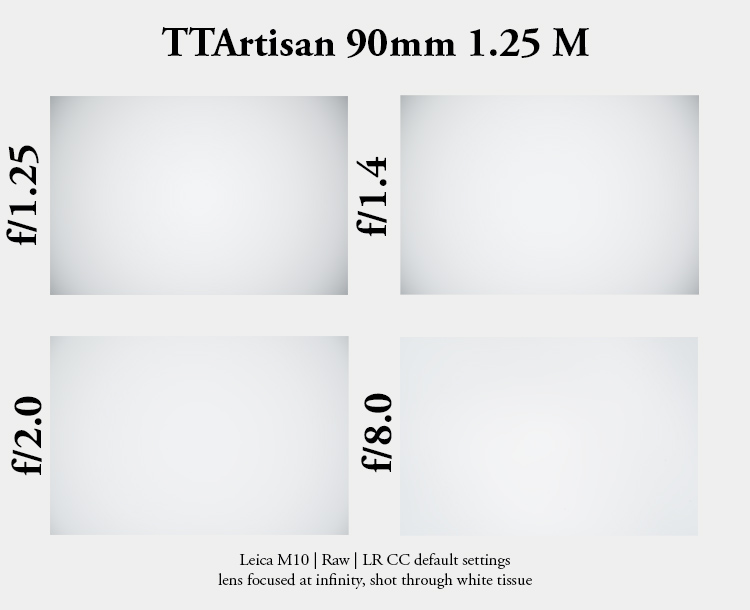
| f/1.25 | 2.3 EV |
| f/1.4 | 1.9 EV |
| f/2.0 | 1.4 EV |
| f/2.8 | 1.0 EV |
| f/8.0 | 1.0 EV |
Vignetting is about average for a lens with these parameters.

It is recommended to have a look at this article first to get an idea how this brightness graph works.
optical vignetting
Very fast lenses usually show a significant amount of optical vignetting. Without going too much into technical details optical vignetting leads to the truncation of light circles towards the borders of the frame.
In the center of the frame almost every lens will render a perfect circle, but only lenses with very low optical vignetting will keep this shape in the corners.
So in the following comparison we move from the center (left) to the extreme corner (right) and see how the shape of the light circle changes.
The optical vignetting towards the corners is clearly noticeable, but this is the case for almost all lenses with comparable parameters. The Sony FE 85mm 1.4 GM is one of the few lenses that is showing an above average performance here.
For comparison’s sake I added the Zhong Yi 90mm 1.5 here. The TTArtisan 90mm 1.25 shows slightly less optical vignetting in the corners, but stopped down the shape of the aperture blades is quite distracting, whereas the Zhong Yi’s aperture blades keep the highlights mostly round. Both lenses do not feature aspherical elements, therefore there are no onion ring structures visible.
I did shoot both lenses side by side, focus distance was 1.1 m.
Sharpness
infinity (42mp Sony A7rII)

At maximum aperture the lens is surprisingly contrasty in the center for an f/1.25 lens.
The midframe starts noticeably softer and needs f/4.0 to look really good.
The corners may suffer due to the thick Sony filter stack, as they never look really great, even stopped down to f/11.
If you are a Sony user and you are looking for a manual focus lens with great infinity performance at wider apertures the Zeiss Loxia 85mm 2.4 is probably the lens you shoud have a closer look at.
Let us see what changes when using this lens on the Leica M10 with its thinner filter stack.
infinity (24mp Leica M10)

On the Leica M10 with its thinner sensor stack midframe and corners show a better performance, so even though the corners do not reach the same level as the midframe areas, you may be happy with the stopped down corners at f/11 for more demanding architecture or landscape work.
portrait distance (2.3 m)
For portraiture it isn’t so important how flat the field is, it is more interesting to see what the sharpness is like when focused at different parts of the frame to take field curvature (and also focus shift) out of the equation.

This is what I did here, I refocused for every shot and aperture to get the best possible result at different locations in the frame (center, inner midframe and outer midframe).
Focus distance was roughly 2.3 m and the circle of the dollar bill is more or less the size of a human eye.
Sony A7III <—> Leica M10
100% crops, Sony A7III, Leica M10
Many of the really fast lenses without a floating elements design have issues with spherical aberration (“glow”) at closer distances, comparing the f/1.25 and f/2.0 center crops we see this is still the case at 2.3 m, as the lens is rather soft at the maxium aperture. It is also one of those lenses where the plane with maximum contrast is not the same as the one with maximum resolution, which makes focusing a bit harder.
Astigmatism is rather well corrected though, so you get a softer look, but resolution should be good enough for most applications also when placing your subject in the midframe area.
close (1.0 m, 1:9.6)
Sony A7rII | TTArtisan 90mm 1.25 | 100% crops from center
The TTArtisan 90mm 1.25 does not feature a floating elements design, so the high amount of spherical aberration at the maximum aperture should not come as a surprise. Therefore – if you are not into a very soft look – it is a good idea to stop down to f/2.8 when taking close up shots.
Flare resistance

The super fast lenses from Zhong Yi, TTArtisan and 7Artisans haven’t been the greatest performers in terms of flare resistance in the past and it seems the TTArtisan 90mm 1.25 continues that trend.
When shooting directly into the sun, especially at wider apertures, you will encounter all kinds of artefacts, rainbow crescents, ghosts, internal reflections.
What I found more bothersome in the field is the high amount of veiling flare though, as even in situations without strong point light sources you will often see it.
Some people might even think it is a low contrast lens because of this, but when shooting scenes without any stray light the contrast actually isn’t low.
The hood isn’t really helping, despite being one of the better designs with felt on the inside. I think it would need to be longer to be actually effective. I often shaded the lens with my hand to get rid of some of the veiling flare.
Coma
Sony A7rII | TTArtisan 90mm 1.25 | 100% crops from extreme corner
Having a look at the sharpness infinity charts it should not come as a surprise that we have to deal with significant amounts of coma and astigmatism in the corners. It really takes stopping down to f/11 to get clean corners.
Distortion

The TTArtisan 90mm 1.25 shows low but slighly wavy distortion. There is no profile for correction available yet in Lightroom.
Bokeh

We are dealing with a 90mm lens with a maximum aperture of f/1.25, so I guess most of you jumped straight to this section.
This 90mm f/1.25 should be the M-mount lens with the biggest entrance pupil yet, so we are at the limit of what is technically possible here. After the 75mm f/1.25 even Leica did not dare to make their 90mm an f/1.25 lens but rather sticked to f/1.5.
Knowing a thing or two about lenses [citation needed] I therefore expected some swirl (high optical vignetting) and maybe some field curvature towards the corners. So let us have a look if I was right about these, investigating the lens’ behaviour at different focus distances.
Close Distance


When taking pictures near the minimum focus distance the background melts away and even though cat’s eyes are noticeable, they are not overly pronounced here.
Mid Distance



At medium distances the bokeh in the center is still butterly smooth, but deteoriates a bit towards the corners, as was expected. You start to see some slight doubled edged structures here, but they are mostly undistracting still.
Long Distance
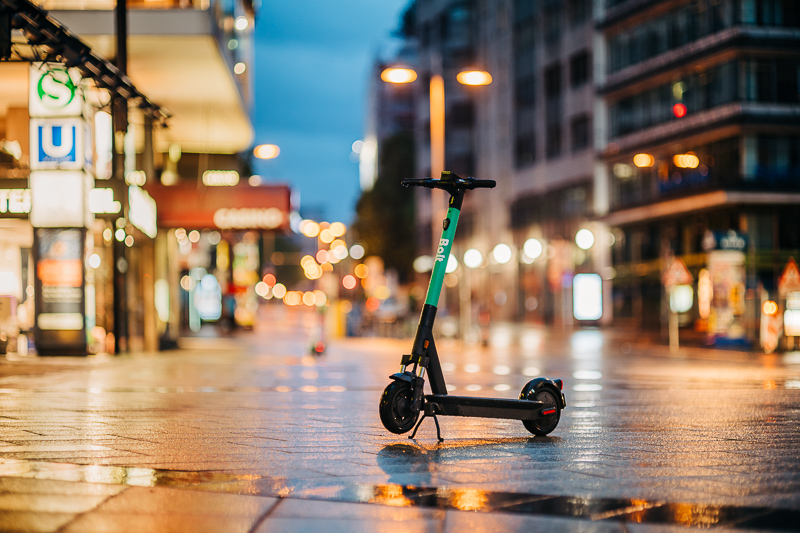



At longer focus distances you can spot some obvious deteoriation and swirl towards the corners. There is probably also some field curvature involved, pulling things in the corners – that are farther away from your subject – almost back into the focal plane.
The TTArtisan 90mm 1.25 is doing a better job at these distances than e.g. the MS-Optics 73mm 1.5 Sonnetar and behaves similar to the much easier to design Leica 90mm 2.0 pre Asph, but it doesn’t offer as smooth across frame bokeh as the latest first party lenses optimized for that like the Sony FE 85mm 1.4 GM.
And we should credit the TTArtisan lens for having a 20% bigger entrance pupil compared to an 85mm f/1.4 lens, which is a lot actually.
Sunstars
The TTArtisan features 10 aperture blades (as do the Zeiss Loxia or Voigtländer lenses) but the alignment of the blades is not perfect, therefore the sunstars are frayed. This should not be a big deal for most portrait applications though.
If you want to learn more about this topic have a look at this article.
Chromatic aberrations
lateral
In the corners you can spot a low amount of lateral CAs which can be easily corrected in post, as can be seen in the example below (100% crop)..
100% crops from extreme corner, A7
longitudinal

I often use close up shots like the one above to highlight longitudinal CA, but in the case of this TTArtisan 90mm 1.25 the spherical aberration is so high that it completely masks them, so we directly have a look what it looks like at longer focus distances.
Sony A7III | TTArtisan 90mm 1.25 | f/1.25
A small amount of loCA are visible, but they are well less pronounced than I would have expected. There are many way easier to design lenses (e.g. Sony FE 55mm 1.8 ZA or Sony FE 35mm 1.4 ZA) that do way worse.
Focus shift
50% crops, A7rII
As I already told you the plane of maximum contrast is not the same as the one with maximum resolution, which in the past often hinted at focus shift and indeed there is noticeable focus shift.
This is bad news when using the rangefinder to focus, but then, why buy a 1 kg 90mm f/1.25 lens when you don’t intend to use it at f/1.25 most of the time?
So if possible stick to liveview for critical focus when using the lens stopped down a bit.
Alternatives
M-Mount
Leica 90mm 1.5 Summilux-M:
Leica’s fast 90mm M-mount lens. I expect better contrast and flare resistance, but that comes at an 18 times higher price.
buy from ebay.com | ebay.de | B&H new for $13.695 (affiliate links)
Zhong Yi 90mm 1.5 M:
The Zhong Yi 90mm 1.5 is more reasonably sized, a bit cheaper and the sharper lens. Differences in bokeh are not huge and I prefer the TTArtisan’s build quality.
buy from the manufacturer’s homepage | B&H | ebay.com | amazon.com for $399 (affiliate links)
Voigtlander VM 75mm 1.5 Nokton:
The difference in focal length is of course noticeable, but so is the weight difference. If you are looking for a really compact M-mount portrait lens, have a look at this one.
buy from amazon.com | amazon.de | B&H | ebay.com | ebay.de for $999 (affiliate links)
Leica 90mm 2.0 Summicron-M pre-Asph:
Used the Leica 90mm 2.0 Summicron-M pre-Asph is similarly priced. It is more than a stop slower but also way more compact and in terms of size and weight a better fit to the M-system.
buy from ebay.com/ebay.de (affiliate links) for $700
E-mount
There are plenty of native options available, covered in our guide to 85-135mm portrait lenses which will give you a good overview.
Conclusion
good
|
average
|
not good
|
A 90mm f/1.25 with its 72mm entrance pupil is situated on the edge of what can be realised for M-mount, therefore I was expecting some optical compromises and indeed there are: flare resistance leaves something to be desired as does the performance near the minimum focus distance as well as at infinity. The latter are not that bothersome for portrait photography, but the ninja star aperture blades do bother me a bit here and those using an M-mount camera without liveview may be bothered by focus shift, too.

Despite this I am pretty sure the TTArtisan 90mm f/1.25 will prove to be a popular lens just like the TTArtisan 50mm f/0.95 before. The combination of unique specs and fair price makes it appealing to many potential buyers, I could even see some trusty Leica users getting one of these lenses for the fun of having a large aperture lens, but without having to invest 5 figures for one of Leica’s offerings.
The TTArtisan 90mm 1.25 can be bought new for $769 at the manufacturer’s shop, amazon.com, ebay.com/ebay.de or B&H (affiliate links).
Sample Images






You can find most of the sample pictures from this review here on flickr in full resolution.
Further Reading
- Sony FE lenses: Our comprehensive and independent guide
- Guide to the best 85-135mm Portrait Lenses for Sony a7 series
- Review: MS-Optics 50mm 1.0 ISM
- Review: Leica 135mm 3.4 Apo-Telyt-M
Support Us
Did you find this article useful or just liked reading it? Treat us to a coffee!
![]()
![]()
![]() via Paypal
via Paypal
This site contains affiliate links. If you make a purchase using any of the links marked as affiliate links, I may receive a small commission at no additional cost to you. This helps support the creation of future content.
Latest posts by BastianK (see all)
- Vivo X200 Ultra – The Death of the compact Camera - June 29, 2025
- Review: Laowa 12mm 2.8 AF - June 26, 2025
- Review: Nikon AF-S 35mm 1.8G - June 21, 2025




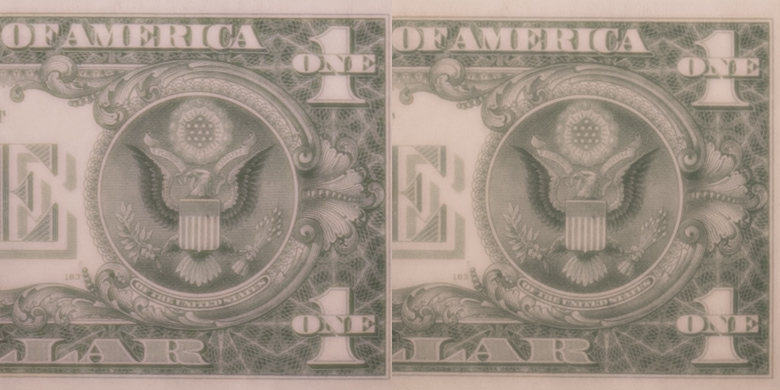






























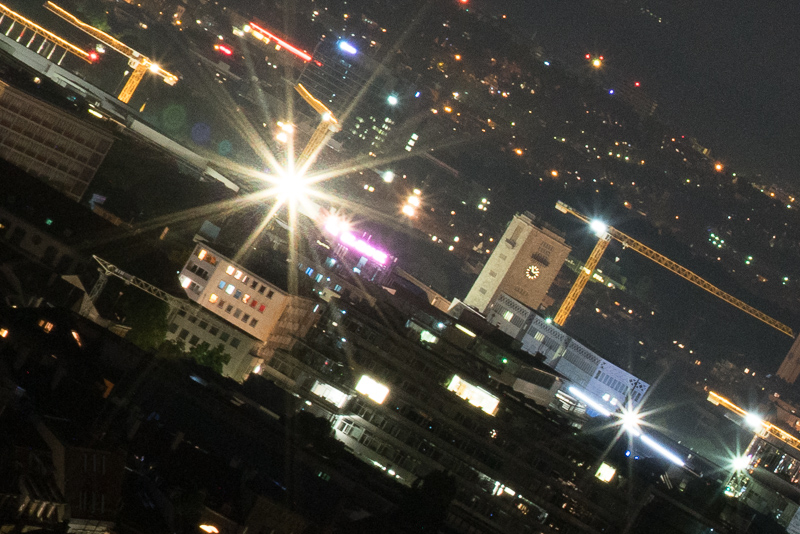






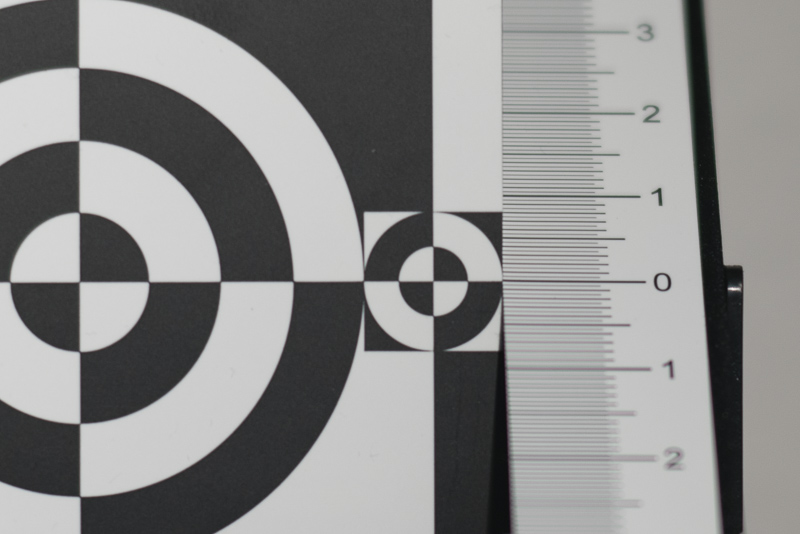


You briefly compared the Voigtlander 75mm/1.5 under the “Alternatives”, but how do you think this new TTArtisan 90 compares to the 7Artisans 75mm/1.25? Reading your review of that lens, I’m under the impression you had a higher opinion of the 7Artisans, but that may just be due to its unique aperture.
“A 90mm f/1.25 with its 72mm entrance pupil is situated on the edge of what can be realised for M-mount”
Curious- why is this the case, and how does it relate to mount diameter/flange distance? I’ve never seen entrance pupil size mentioned like this.
Is it that its difficult to reduce down from 72mm to the diameter of M mount?
M-mount is not considered in this article, but the idea should be conveyed.
There are many simplifications though, as in this article they only look at the center whereas the issues start to be obvious in the corners, especially on tele lenses.
If you look at the rangefinder coupling of the 10k Leica lenses you will also notice that they had quite some issues to fit the mechanism in, as the rear elements are at the absolute limit of what is possible.
Therefore 90/72=1.25.🫢
Wow! Thank you so much for this review!
But since when did Zhong Yi build 90mm f1.5? I have never heard of this lens before and can’t find any information on the internet. Looks like you are going to review it soon? I’m looking forward to it!
It should be announced soon 😊
Regarding the question of why Leica did not make their new 90mm faster than f/1.5, it is answered at around 1:05:00 in this video presentation by Peter Karbe: https://www.youtube.com/watch?v=mZ1xM7qVSXo
They chose to limit the entrance pupil diameter to a maximum of 60mm and standardized many of the parts of the 75/1.25 and 90/1.5, including the first four lens elements, aperture, focusing mount and housing parts.
I didn’t have time to go through the full video again to find it (assuming it’s mentioned in this video), but IIRC, the 60mm entrance pupil limit was also a factor in considering the maximum possible diameter of the lens while not obstructing the view of the rangefinder mechanism at MFD.
The Leica 90/1.5 is slightly smaller than the TTA 90/1.25 at 74mm diameter and 91mm long vs. 82x97mm, but you didn’t mention any focusing problems with the TTA at MFD with the M10’s rangefinder, so I’m not sure how critical this point is. While the Leica 90/1.5 has the same 1m MFD as the TTA, the Leica 75/1.25, which is the same physical size as the 90/1.5, has a MFD of 85cm. Therefore this point about preventing RF blockage might be more relevant for the 75. The 90’s 1m MFD limit is likely due to the shared focusing mount with the 75, which likely doesn’t permit enough travel/extension for a shorter MFD.
I think that 7Artisans 75mm/1.25 is more 3D look. It has more character for people and street photos. 90mm looks to flat.
Bastian, are there any m-mount lenses that you know of that aren’t compromised in their performance at all when you adapt them to e mount?
Ah I really had to think about this one.
I only have the M10 for 1 1/2 years so there are plenty of M-mount lenses whose performance I didn’t check on the M10 as well.
Many people (me included) used to believe that with longer lenses there will be no differences, yet I see significant differences with all the 90mm lenses I checked. Would be interesting to check a 135mm lens…
I think 7Artisans 28mm 1.4 FE+ and Laowa 9mm 5.6 do really good on both sensors.
Not saying there are no differences at all, but they are so small that they are rather meaningless imho.
Well there doesn’t seem to be a point of using the m-mount version of the Laowa anymore but it seems that slow telephoto lenses seem to perform without any issue maybe? Like Leica 135 f4 and f3.4. I wonder if there are any others though. ¯\_(ツ)_/¯
While one quite understands that all the charts and brick walls tests for lenses are legitimate and warranted , there are certain cases where you forgive them like the mama’s cooking that fall apart on six out of seven days.. yet– we yearn for it. These lenses are made for the feel they provide, are character glasses and may or may not have been corrected to the ‘T’. Many of the readers who just look into the charts and exclaim ” Oh! No use till F11 or there goes the fringing at the extreme corners @200%– et al.. may find this a wee bit off the tangent for practical purposes. The truth is, unless one prints and exhibits , no social media representation of even the best judges will knock twice to say.. Oh, that one @ F 1.5 at a distance of two meters has a problem..
Are there any:
200% crops in this review?
Brick walls?
Did anyone say you need to stop the lens down to f/11 to get rid of loCA?
Or did I rather say:
The ninja star aperture diaphragm will be very distracting if you stop the lens down a little.
Flare can and often will ruin the complete picture.
It is a brick of a lens you need to be sure you want to carry around.
And this “oh you don’t need a high resolving lens for social media” argument is one of the cheapest these days.
If your intention is to have a lens that is just barely good enough to do the job for instagram maybe you don’t need a lens like this at all, your phone will be sufficient.
You seriously need to test Samyang XP 85mm f1.2 against them!
I had this lens for over 2 years and I made incredible amount of great photos.
If not that I needed AF I would have never sold it!
If one falls into my hands I will review it 🙂
The lens was updated for mirrorless systems for $ 435!!. I wanted to change my laowa 105 (Sony FE) for him, but the weight confuses me. Your opinion ?
Check sample pictures of both lenses and see what kind of look you prefer, if you know that you know which lens is better for you 🙂
I don’t understand the discrepancy between sample images sharpness vs. the test shots which show softness in the midframe and corners. An example of that is the girl with the umbrella which clearly shows the ground in the right bottom corner being sharp, not to mention the girl who is definitely not in the midframe, shot is taken at f/1.25. The only explanation I have is that the image was cropped, if that is the case this detail should have been mentioned.
If you look at the full resolution picture you will notice that neither the girl nor the ground are particularly sharp.
They just look like that because thanks to the thin depth of field these areas stand out as being much sharper than the rest.
I am on the way buying this lens for a Hasselblad 907X coupled to a CFVII50C digital back. In an another article I´ve already read that this lens will/could have problem(s) to fill in the/its complete
sensor frame of 43,8mm x 32,9mm (I have also the “old” CFV50 with 49,1mm x 36,7mm, but this will/would be even worse/useless) has/will have vignetting. Also at commercial stores/sites you can/will find this warning: “Performance on Medium Format: When used on … Hasselblad medium format cameras, there might be slight vignetting, but it’s reportedly minimal”. Concerning the most wanted/exercised purpose using it for portrait, it seems to me beeing a
more or less academic discussion. It will/should be mostly used by me for portrait and as an owner of an “old 1:2/110mm from Zeiss”, even with a big flare/damage on/at the frontlens, and taking “special portraits” with a very old
legendary “Rodenstock Imagon H=4,8/200mm” I am more/most(ly) interested in the created/existing bokeh comparing it to them!
Just yesterday I saw some pictures on social media with this lens on an Hblad, it looked like a very interesting combination to me!